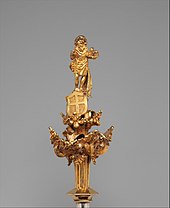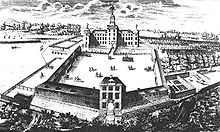Diocese of Lübeck

The Diocese of Lübeck was a Roman Catholic diocese in what is now Schleswig-Holstein .
Foundation in Oldenburg
After the attempt to evangelize the Slavs with the Oldenburg diocese at the end of the 10th century finally failed in 1066, the Slavic mission was resumed from Bremen in 1126 .
After various origins presented Emperor Lothar in 1134 at the suggestion of the Bishop of the Bishopric castle and pen Segeberg . Equipped with a further 300 Hufen land in 1156 , the bishop established the market and bishop's court of Eutin on this land .
Relocation to Lübeck
In 1160 or 1163 the bishopric was moved by Duke Heinrich the Lion from Oldenburg in Holstein to Lübeck , where a cathedral chapter was also established at the Marienkirche .
In 1173 the bishop's investiture passed from the duke to the emperor . Since then, the parish organization has also developed increasingly within the diocese. If there were only 15 parish churches outside Lübeck in 1163, the number of these rose to around 21 by 1200 and around 45 by 1259.
The rise of the bourgeoisie in the 13th century led to disputes between the representatives of the bourgeois and those of the clergy. Lübeck's Bishop Burkhard von Serkem fled to Eutin several times and founded the Eutin Collegiate Foundation there , which promoted the conversion of St. Michaelis Church from Romanesque to Gothic styles. He wanted to show the people of Lübeck that the bishopric could be somewhere other than the Hanseatic city, which ultimately happened for a few years.
Heyday
The cathedral chapter , which was always economically separated from the bishop, comprised a provost and 12 prebends in 1160 . Already in the 13th century, the chapter grew to 30 prebends by the 14th century, but only 19 of them had a seat and vote in the chapter. According to the statutes, 16 canons were supposed to be priests after 1400, in 1524 there were 25 of 28 resident canons. The chapter added itself in rotation; only 3 prelatures and 5 prebends were occupied by the bishop.
In 1524 the diocese had 57 parishes, only 3 of which were incorporated into the bishop. In addition there were 200 vicarages within Lübeck and 150 vicarages outside the city. In addition to two foundations (Segeberg and Eutin), five male and three female monasteries, there were also 20 minor benefices.
The diocese comprised only an archdeacon , and the provost also served as archdeacon. From 1396 there were also general officials. The bishop, who usually resided in Eutin Castle, did not oppose the Reformation . Protestant church ordinances were issued as early as 1531 (for the city of Lübeck) and 1542 (for the monastery area) .
reformation
While the diocese perished as a spiritual unit in the Reformation, the ownership of the chapter and bishop, the Lübeck bishopric, remained as territory.
literature
- Wolfgang Prange : Bishop and cathedral chapter of Lübeck. Hochstift, Fürstentum und Landesteil 1160-1937 , 2004, 728 S., Max Schmidt-Römhild Lübeck, ISBN 978-3-7950-5215-7
- Antjekathrin Graßmann (Ed.): Lübeckische Geschichte. Schmidt-Römhild, Lübeck 1989, ISBN 3-7950-3203-2
- Heinrich Behrens : Coins and medals of the city and the diocese of Lübeck , Verlag der Berliner Münzblätter, Berlin 1905, unaltered reprint: Winfrid Bogon Verlag for digital publications, Berlin 2008, ISBN 978-3-936059-30-4


